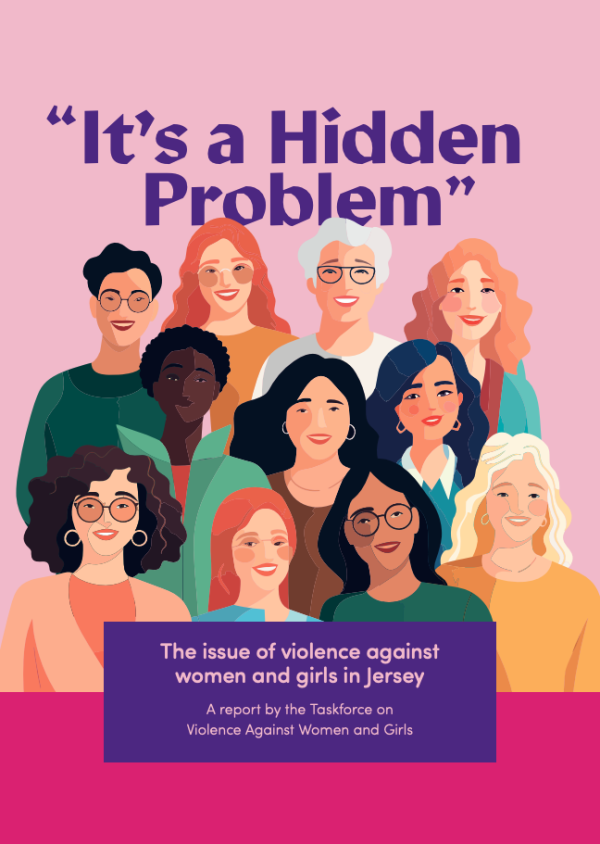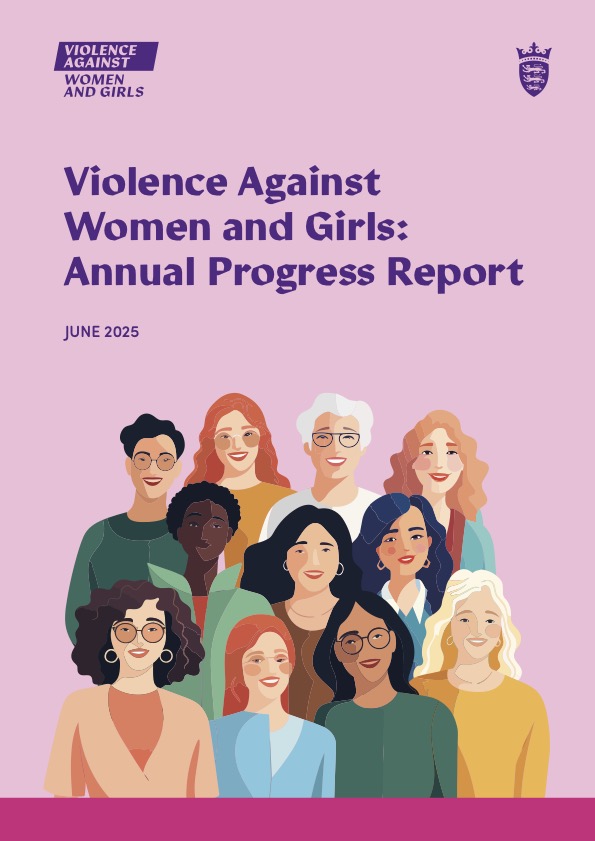Kate Wright, chair of the Violence Against Women and Girls Taskforce and CEO of FREEDA, explains how the findings and recommendations of the report are being implemented.

The publication of the Violence Against Women and Girls (VAWG) Taskforce report in Jersey marked a significant turning point in the Island’s approach to tackling gender-based violence. Yet, as Kate Wright, the chair of the taskforce behind the report, emphasises, addressing this crisis goes far beyond government policy or the criminal justice system. It requires a collective effort – from schools, health services, employers, families and the wider community.
Since the report’s release, there has been notable progress in embedding this collaborative approach into Jersey’s response to violence against women and girls. But understanding how this complex social issue touches every part of the community is vital if we are to prevent violence before it happens – and provide effective support to those affected.
Beyond Government: A whole-community challenge
The VAWG report made it clear that the government, while a major stakeholder with 53 direct recommendations, cannot solve this issue alone. Law enforcement and the criminal justice system have their roles, including ongoing independent reviews of the police and family courts, aimed at closing gaps and strengthening legislation. But equally important are the roles played by schools, health services, employers, and the community at large.
Schools: Educating for prevention
One of the most encouraging developments has been the engagement of schools. Representatives from schools formed part of the taskforce, and their response has been “phenomenal”, according to Kate. “There is a toolkit that’s been designed and developed via a subcommittee of the taskforce and other professionals working in schools that will be rolled out in the autumn term, so that there’s much more education around VAWG woven into the PSHE (Personal, Social, Health and Economic) curriculum,” she added.
This education is critical. Teaching young people about healthy relationships and consent equips them with the tools to navigate their futures safely and respectfully. Kate highlights a concerning finding from their research – many young people had normalised forms of harassment and abuse to the extent they did not even recognise them as such. Starting prevention education early, within schools, helps to break that cycle and change attitudes from the ground up.

“There is a toolkit that’s been designed and developed via a subcommittee of the taskforce and other professionals working in schools that will be rolled out in the autumn term, so that there’s much more education around VAWG woven into the PSHE (Personal, Social, Health and Economic) curriculum”
Kate Wright, VAWG Taskforce Chair
Health services: A frontline for identification and support
Healthcare professionals, especially GPs, are often the first point of contact for victims of abuse. The taskforce has prioritised training for GPs to identify the less obvious signs of domestic abuse, which can be psychological, emotional, financial, and coercive rather than physical bruising. This training enables healthcare workers to spot vulnerability, open conversations sensitively, and signpost individuals to charities such as FREEDA and JDAS or the police.
There is also an awareness of less obvious connections, such as the link between pet abuse and domestic violence, meaning even vets can play a part in recognising and responding to abuse.
Employers: An often overlooked role
Employers have not always been seen as obvious stakeholders, but they are crucial in the fight against violence. Kate explained: “For some victims of domestic abuse, the workplace might be the only safe environment. Employers and colleagues can sometimes notice changes in behaviour – withdrawal, avoidance of social events, excessive phone calls from a partner – that may signal someone is struggling.”
The Safeguarding Partnership Board has developed toolkits for employers, and FREEDA conducts regular awareness sessions to help workplaces become safer spaces. Employers don’t need to be experts in VAWG but should be able to recognise ‘red flags’ and know how to signpost support.
The vital role of charities and community groups
Charities and community groups such as FREEDA, JDAS, JAAR, the Salvation Army and Caritas have been integral to the taskforce and the progress made since the report. These organisations work daily with victim-survivors and provide invaluable insight into the gaps in support and funding.
Kate stresses the importance of these charities in shaping the taskforce’s recommendations, offering feedback, and co-developing solutions. They not only provide immediate help but also help foster long-term cultural change through community outreach and education.
Overcoming resistance: Changing attitudes and culture
No meaningful change is without resistance. Early feedback was described as “shocking and hard”, and some stakeholders felt defensive. There has also been public pushback, particularly from some men, revealing persistent misogyny and cultural barriers to acknowledging the problem of VAWG.
Kate notes the deep-rooted causes – gender inequality and misogyny – cannot be addressed without compassionate engagement with men, recognising that restrictive gender norms harm both women and men. Partnering with a men’s mental health charity is helping FREEDA to understand how unrealistic expectations of masculinity contribute to poor mental health and, in some cases, violent behaviour.
Increasingly, awareness is growing that men can also be victims of domestic abuse, a fact highlighted by recent campaigns and media coverage. JDAS and charities offer support to men as well, acknowledging the complex dynamics of abuse and the need for inclusive support.
Public awareness and young people’s voices
Public support for tackling VAWG has been significant, partly because the issues resonate so deeply. A striking statistic from the public survey showed that 97% of women reported experiencing some form of sexual harassment – a near-universal experience.
Young people were heavily involved in the research underpinning the report, with 1,800 students taking part in surveys and focus groups. Their experiences highlighted a worrying normalisation of abuse and harassment – behaviours dismissed as everyday or ‘wallpaper’ to their lives.
Kate describes a chilling cultural disconnect: young people say Jersey is “safe,” yet their experiences tell a different story. This reflects a societal tendency to protect the Island’s reputation at all costs, sometimes at the expense of acknowledging and addressing real safety issues. Recognising this ‘gaslighting’ effect is a critical step toward meaningful cultural change.

Read the full Violence Against Women and Girls Taskforce Report here
What’s next? Building on momentum
Since the report’s publication, progress has been “phenomenal”. The government’s immediate acceptance of all relevant recommendations, led by Chief Minister Deputy Lyndon Farnham, shows strong political commitment.
However, Kate Wright stresses that change will take time. Proper investment and sustained effort across all stakeholders are essential for implementing fundamental system changes. These changes aim to empower people to challenge the status quo and foster a culture that refuses to tolerate violence or harassment.
Perhaps the most inspiring outcome has been the empowerment of survivors. Many have shared how being listened to and believed has helped them find strength to move forward. This survivor-led momentum is driving real, lasting change for current and future generations.

The Violence Against Women and Girls: Annual Progress Report has now been published on the Greffe website: here
Final thoughts
The fight against violence against women and girls in Jersey is no longer a marginal issue; it is recognised as a community-wide challenge demanding collective responsibility. The VAWG report has provided a roadmap not only for government but for schools, healthcare, employers, charities, and every individual in the Island.
Educating young people, training professionals, engaging employers, supporting survivors, and changing cultural attitudes – especially around gender norms – are all critical steps on this journey. While the road ahead remains challenging, the progress made so far offers hope that Jersey can become a safer, more equitable place for all its residents.
Learning from other jurisdictions was integrated into the recommendations, including the UK because our legal systems and frameworks closely mirror one another. Kate added: “Another jurisdiction that really interested me, and we turn to time and time again, was Australia. There has been some really great work around violence against women and girls, particularly through the lens of looking at the experience of their indigenous people. So we took a lot of inspiration and learning from the UK and Australia.”
Kate concluded: “Where we are at now with those 77 recommendations accepted by the various stakeholders, if they’re delivered well and it’s not just a tick-box exercise, then we are going to be leading the world actually, and I think that’s incredible.”
Kate Wright, chair of the Violence Against Women and Girls Taskforce, is the subject of a Bailiwick Podcast. Click here to listen: How Jersey is tackling violence against women and girls?
 blog.gov.je
blog.gov.je